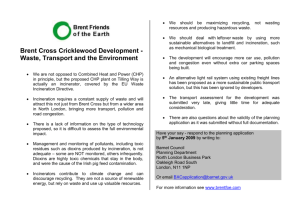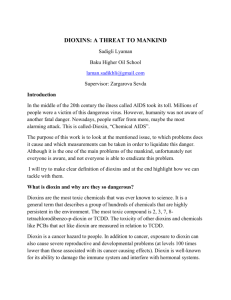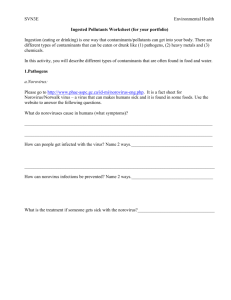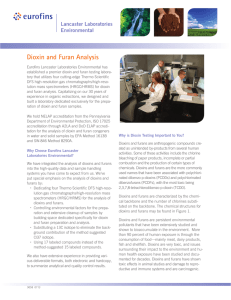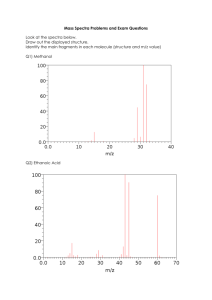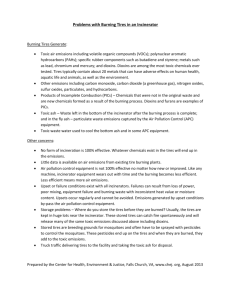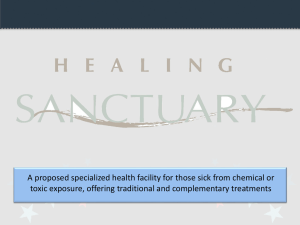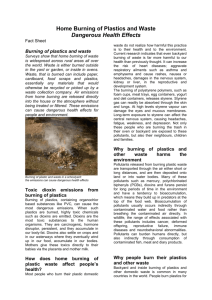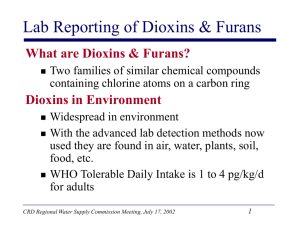Advancing Sustainable Materials Management: Facts and Figures
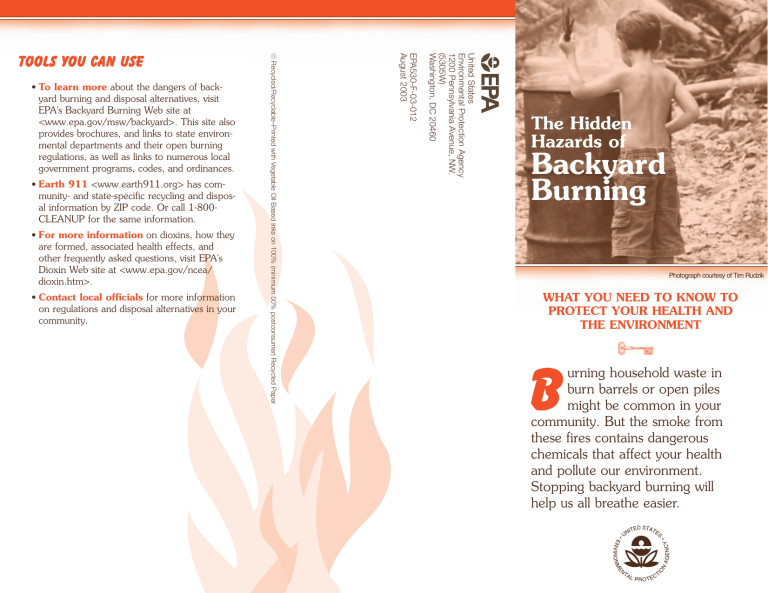
Tools You Can Use
• To learn more about the dangers of backyard burning and disposal alternatives, visit
EPA's Backyard Burning Web site at
<www.epa.gov/msw/backyard>. This site also provides brochures, and links to state environmental departments and their open burning regulations, as well as links to numerous local government programs, codes, and ordinances.
• Earth 911 <www.earth911.org> has community- and state-specific recycling and disposal information by ZIP code. Or call 1-800-
CLEANUP for the same information.
• For more information on dioxins, how they are formed, associated health effects, and other frequently asked questions, visit EPA's
Dioxin Web site at <www.epa.gov/ncea/ dioxin.htm>.
• Contact local officials for more information on regulations and disposal alternatives in your community.
The Hidden
Hazards of
Backyard
Burning
Photograph courtesy of Tim Rudzik
WHAT YOU NEED TO KNOW TO
PROTECT YOUR HEALTH AND
THE ENVIRONMENT
B
urning household waste in burn barrels or open piles might be common in your community. But the smoke from these fires contains dangerous chemicals that affect your health and pollute our environment.
Stopping backyard burning will help us all breathe easier.
Backyard Burning Is a
Health Hazard
Backyard burning is a more serious threat to public health and the environment than previously believed and has been banned by many state and local governments. Burning household waste produces many toxic chemicals and is one of the largest known sources of dioxins in the nation.
Dioxins
What are dioxins?
Dioxins are highly toxic, long-lasting organic compounds. They are dangerous even at extremely low levels and have been linked to several health problems, including cancer and developmental and reproductive disorders.
How are dioxins formed?
Dioxins are formed when products containing carbon and chlorine are burned. Even very small amounts of chlorine can produce dioxins.
Because burn barrels do not have the same strict controls as municipal incinerators, barrel burning releases significant amounts of dioxins. Trying to prevent dioxins from forming by separating out items high in chlorine content is not effective, since low levels of chlorine are present in most household trash.
How are we exposed to dioxins?
Dioxins accumulate in the food chain. Airborne dioxins can settle onto feed crops, which are then eaten by domestic meat and dairy animals.
Dioxins also can settle on water or enter waterways through soil erosion. These dioxins accumulate in the fats of animals, and then in humans when we consume meat, fish, and dairy products.
Other Air Pollutants
Smoke from burn barrels contains hazardous pollutants such as particulate matter, sulfur dioxide, lead, mercury, and hexachlorobenzene. These pollutants can have immediate and long-term health effects such as:
• Asthma, emphysema, or other respiratory illnesses.
• Nervous system, kidney, or liver damage.
• Reproductive or developmental disorders.
Not only are the people who burn trash exposed to these pollutants, but so are their families and neighbors.
Children, the elderly, and those with pre-existing respiratory conditions can be especially vulnerable.
Ash
The ash residue from backyard burning can contain toxic pollutants, such as mercury, lead, chromium, and arsenic, which can contaminate vegetables if scattered in gardens. Children can accidentally swallow toxic materials from dirt on their hands while playing near discarded ash.
Dioxin in the food chain
What You Can Do
• Reduce.
You can reduce the amount of waste you generate by using durable, longlasting goods and avoiding disposable items; buying products in bulk; and looking for products with less packaging.
• Reuse.
Reusing items is another way to reduce the amount of waste you generate.
Repair, sell, or donate used or unwanted items or organize a neighborhood swap event. One person's trash is another person's treasure!
• Compost.
Composting is a great way to dispose of yard trimmings and food scraps, while creating a natural, free fertilizer. Many communities offer weekend classes on how to compost, and some even provide composting bins at a reduced cost or show you how to build your own.
• Recycle.
Contact your local government to find out about curbside pick-up of recyclable materials or drop-off locations.
• Properly Dispose of Waste.
Don't litter or dump illegally. Use a waste collection service or take your waste to a transfer station, convenience center, or local landfill.
Check with your local officials to learn about collection service and drop-off sites in your community.
For more information on these steps you can take, visit EPA's Municipal Solid Waste Web site at <www.epa.gov/msw> and click on "Reduce,
Reuse, and Recycle."
